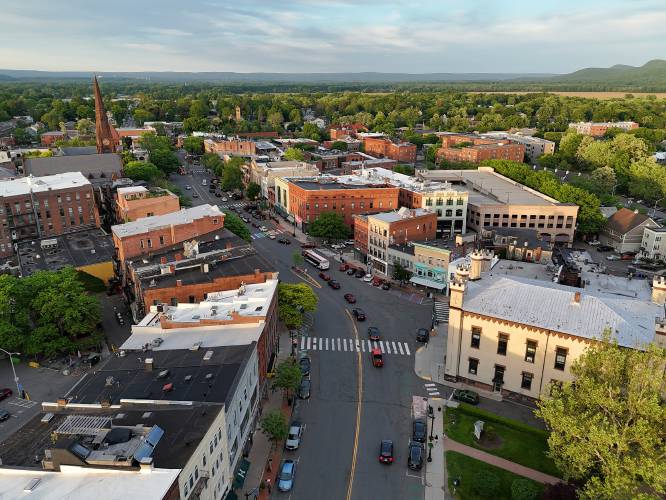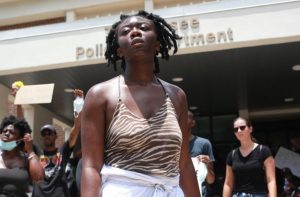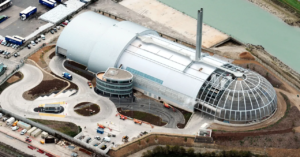NORTHAMPTON — Nearly two years after its creation, the Northampton Commission for the Study of Reparations has released its preliminary report on how to address historic wrongs against Black residents and workers in the city, which proposes both structural and symbolic change in the city.
The report makes 15 recommendations with the stated goal to “ameliorate to some degree some of the malevolent harms caused by slavery and its multi-generational aftermath.” The report was crafted by the commission, a nine-member body on which the majority of members are Black.
In introducing the report to the City Council at its Dec. 5 meeting, commission chair Ousmane Power-Greene began by saying that the city had a complicated legacy when it came to racism, on one hand being a major center of abolitionist activity prior to the Emancipation Proclamation, and on the other having 129 years of legal slavery before its outlawing in Massachusetts in 1783.
“The work of the Northampton Commission for the Study of Reparations begins with the shared understanding and acknowledgment that Northampton’s history involves slavery, racial discrimination, and systemic racism,” Power-Greene stated. “It is also the case that this city has a deep history of community centered around abolition activism that included free Black people, formerly enslaved people and white allies who contributed greatly to the cultural and historic fabric of Northampton and throughout the struggle against racial injustices locally, nationally and globally.”
One key highlight the commission found through its investigation was the existence of more than 240 historical property deeds, covering approximately 55 properties across Northampton, that contain language of racial exclusion for those properties. The report states that of those deeds, more than half contained explicit racial language (“These premises shall not be conveyed to or occupied by any colored persons”) while others contained more coded phrasing (“The premises shall not be sold, rented or leased to any person or class of persons whose ownership would be injurious to this locality for residential purposes”).
Most of the exclusionary deeds were conveyed between the years 1923 and 1947, with many originating from a tract owned by a developer named Charles Sauter. But the report also stated, citing the Hampshire County Registry of Deeds, that there were 40 deeds still on record that continued to incorporate previous racial restrictions, though they are unenforceable today.
“These restrictive covenants evidence institutionalized and systemic racism that was apparently accepted by and acceptable to major institutions, e.g., banks and other lending institutions, in the city as well as prominent citizens, including lawyers,” the report states. “These covenants constitute wrongs committed against African-Americans and demonstrate that their ability to purchase property and live in Northampton was deterred by financial institutions.”
The report called on many of the institutions that financed such deeds still in existence, such as local and national banks doing business in Northampton, to participate in any reparations efforts by the city to address these wrongs. The commission’s final report would include more details regarding such actions, along with responses of the institutions. That report is to be released at a later date.
In addition, there also are calls for more symbolic steps the city can take to show appreciation for the its Black community, such as renaming a major thoroughfare street after Sojourner Truth, a prominent Black abolitionist and women’s rights activist who was born a slave and later lived in Northampton for some time. It also called on the city to pass resolutions supporting federal and state legislation supporting measures on reparations.
During the latest City Council meeting, reparations commission member Marsha Morris said that despite the findings and recommendations of the report, there remained much work to do for the commission if the city wants to address the legacy of racial inequality, and to get more community members involved in that discussion.
“The whole point of the report was to look at redress from the point of view of Black people, African American people in particular, and we simply have not done that,” Morris said. “It’s one thing to look at that in a bubble. It’s another thing to bring community into that discussion, so that we can do that in a synergistic way and create recommendations that get to the nitty and the gritty of how this impacts Black people’s lives day to day.”
Renika Montgomery-Tamakloe, another commission member, also called for the commission to be given more time to finish its final report, currently expected to be released in March.
“This phase of the work is actually the most pressing,” Montgomery-Tamakloe said. “This is us going out into the community, speaking with community members … to people who may not necessarily live in Northampton, but who work in Northampton and who are still affected to this day by the way things have shaken out in Northampton, the way that the demographics of where are the Black people in Northampton and where are the poor people in Northampton.”
The commission’s call for more community engagement was met with agreement by Councilor At-Large Garrick Perry, who is also a member of the commission and currently the only Black city councilor. Perry called for surveys to be filled out by community members to help in its report.
“It’s hard to get people to commit to filling out forms and things but I think that it’s important to do that work,” Perry said. “This has been a step-by-step process that I’ve been thankful to be a part of in my time here.”
Northampton Mayor Gina-Louise Sciarra, though acknowledging the commission’s statements that more work needed to be done, also praised the preliminary report during last Thursday’s council meeting.
“It’s very robust, there’s a lot to it,” Sciarra said of the report. “I’ve already asked my office to start looking at [the recommendations] and seeing what we could start working on now, even though it’s preliminary.”
Source: https://www.gazettenet.com/Preliminary-report-of-reparations-commission-58434796




